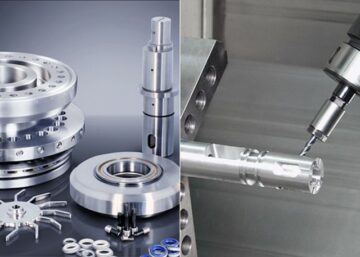Cylinder head machining comprises several techniques for making or resurfacing a cylinder head. Although other manufacturing processes are suitable for the part, CNC machining is the favorite of automotive part manufacturers that want a high degree of flexibility and accuracy. This does not only apply to cylinder heads, as CNC machining is the choice of method for other parts, as seen in machined CNC motorcycle parts and gear manufacturing.
The cylinder head is an important part of all vehicles and houses components such as the spring, combustion chamber, lifters, and spring. It has a complex design due to the constituting components, making its manufacturing or resurfacing critical. This article talks about cylinder heads, the machining process, and things you need to consider about cylinder head machining.
Cylinder Head Basics: Definition, Components, and Importance
The cylinder head is a separate cast piece bolted to the upper part of the cylinder block that delivers air and fuel and removes exhaust gas from the cylinder. It is made from iron or aluminum and houses the following components.
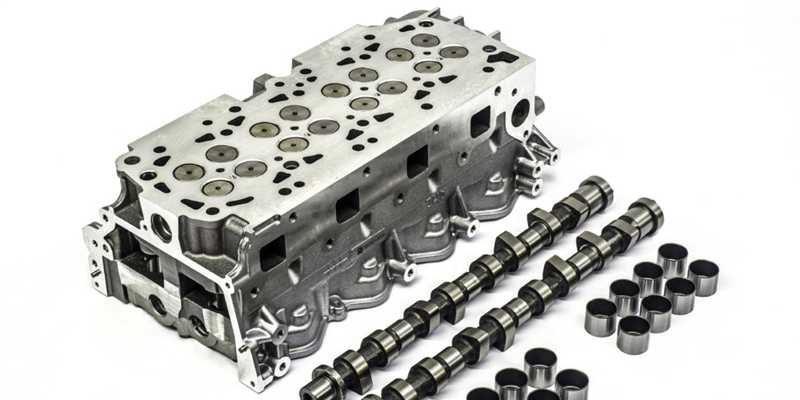 Components of A Cylinder Head
Components of A Cylinder Head
- The Head gasket is in between the cylinder head and the engine block, where it acts as a seal. As a result, it prevents the leakage and mixing of oil and engine coolant;
- Intake ports function in air circulation into the combustion chamber and cylinder head;
- The exhaust port removes exhaust gases from the combustion chamber, reducing internal pressure that can cause an explosion;
- Spark plugs provide the power to kickstart the combustion process;
- The Head camshaft is responsible for closing and opening the valves;
- Additional cylinder head parts functions in the circulation of coolants and lubricant into the engine.
The Importance of Cylinder Head
The cylinder head is very important in car part manufacturing, such as:
- It houses components such as the inlet and outlet exhaust valves and ducts, fuel injectors, spark plugs, and camshafts.
- Serving as a channel for coolant, oil, and combustion gases.
- Absorption of the heat made by the engine, thereby cooling it and preventing engine failure
- Function in sealing the combustion chamber. As a result, it serves as the engine’s mechanical control powerhouse.
- Taking away the compression that comes from the combustion pressure.
Comparing Cast Iron vs. Aluminum Cylinder Head
The cylinder head functions in an environment of high temperatures. As a result, the choice of material buildup is very important. Of the materials used for making the parts, cast iron and aluminum are the most common.
On the one hand, automotive part manufacturers prefer using cast iron as the main material for cylinder head machining due to its durability and cheapness. However, it is heavy and has less heat dissipation. On the other hand, cylinder heads made from aluminum are lighter hence their application in performance and race cars. As of now, gasoline engines use an aluminum head, while diesel engines majorly use cast iron
Types of Cylinder Heads
There are three types of cylinder heads you can take note of before you begin the engine head machining:
 Flathead Cylinder Heads
Flathead Cylinder Heads
These cylinder heads have no moving parts and are the earliest and simplest cylinder head. The situation of valves on the edges of the engine block leads to an inlet of gases moving at a right angle. This then results in inefficient combustion and a minimum ratio of compressibility.
The flathead cylinder head is rare to find because of the flaws in its design. Nevertheless, they have better coolant flow and are the easiest to manufacture.
 Overhead Valve Cylinder Heads
Overhead Valve Cylinder Heads
Due to their complex design, these cylinder heads are superior to flatheads. They are also called the l-type cylinder and have their camshafts above them. As a result, they are more efficient due to the fast and smooth flow of gases and coolants.
 Overhead Camshaft Cylinder Heads
Overhead Camshaft Cylinder Heads
These are the most advanced cylinder heads. In this type of cylinder head, the camshafts are inside the cylinder head. As a result, there are no pushrods. Furthermore, this ensures better airflow, which increases engine efficiency.
Custom Cylinder Head Machining Processes
Before entering mass production, you need to test each function of the cylinder head. However, the cylinder head has a complex design and requires tight-tolerance manufacturing processes. As a result, the mold should preferably be finished with CNC machining. Aside from tight tolerance, quality is very important for improved vehicle performance and cost-efficiency. Below are the common machining processes.
Precision Milling
Milling cylinder heads is a very common process that involves cutting a workpiece using a CNC milling machine to remove materials and form the cylinder head components such as the slots, holes, pockets, and contours. Aside from manufacturing, it is employable in precision cylinder head machining to reduce the combustion chamber volume or build a higher compression.
Note: CNC milling cylinder heads are best for working on an already-machined workpiece
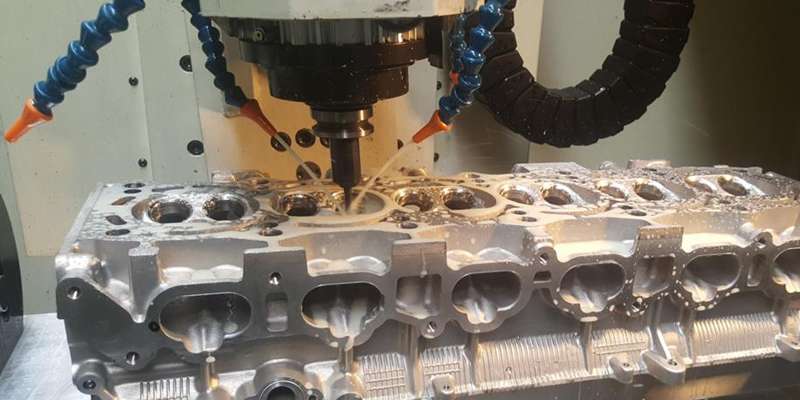 Drilling
Drilling
Drilling is another process that involves using a rotating cutting tool, also called a drill, fixed with a drill bit to make a round hole in a workpiece. In cylinder head machining, CNC drilling is suitable for making holes and channels for the passage of coolant, oil, gas, etc.
While machining the cylinder head, place the drill perpendicular to the workpiece to minimize drifting. Also, certain workpieces need angular drilling, and you might need a special work-holding tool to perform angular drilling operations.
Precision Turning
CNC Turning is a CNC technique that involves holding and rotating the workpiece and feeding the tool to the workpiece to create the shape. It is a suitable technique for making components such as ports. Aside from that, it is suitable for refining the cylinder head after techniques such as long foam casting.
Design Considerations in Cylinder Head Machining
Before a cylinder head is machined, you must give adequate attention to the areas that may influence the requirement, design, or mode of operation. Common considerations and related techniques include:
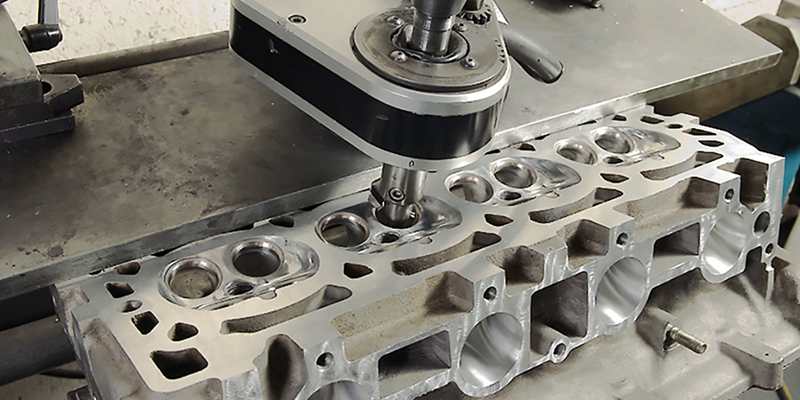 Use the right drill bits
Use the right drill bits
For the drilling bit part, ensure that the right drill bit is used, especially regarding the expulsion of chutes. Using the wrong drill bits can lead to the wrong dislodgement of chutes, affecting the drilling process.
Airflow Numbers
There is a misconception that the greater the airflow numbers of a cylinder head, the more power it would generate. However, they will be under the right condition if the engine can make most of the flow potential of the cylinder heads. Otherwise, it would lead to going for cylinder heads that are too big for a particular application.
Design Variants that Will Enable Optimal Airflow
The variables below are the few that would determine the airflow through a given cylinder head:
- The profile, structure, position, and volume of the inlet of exhaust ports.
- The valve stems’ diameter.
- The valve seat angles.
- The inlet runners’ height is proportional to the location of the inlet valves.
- The structure and volume of the bowl area are just higher than the valves.
- The guide support and valve guide size in the intake runners.
- The inlet and exhaust valve sizes.
Reducing Valve Angles
Reducing the valve angle will increase the cylinder head performance and airflow. This was confirmed when working with gasoline V8 engines, which slanted valves at an angle to the deck surface of the cylinder head.
Due to the design, there is an accommodation of the valve train geometry that activates the valve and increases airflow. As a result, cylinder head manufacturers now design a range of heads with narrower valve angles like 10, 12, 15, 18, 21, etc.
Diesel Difference
Most heavy-duty and light diesel engines have comparatively small ports, and their valve angles are flat. The valves go up to the deck surface of the cylinder.
The design of the engine head renders good velocity at minimal rpm and airflow for a good torque output. However, it does not generally provide good airflow at an rpm higher than stock.
Common Manufacturing Processes for Making High-volume Cylinder Heads
If you need a large number of cylinder heads, you can use many other cylinder head manufacturing processes instead of CNC machining. A common one is load foam casting, and the other two common manufacturing processes are lost foam casting and die casting.
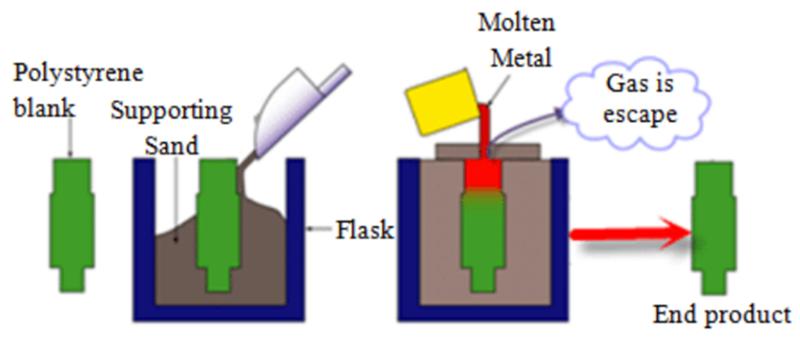 Lost Foam Casting
Lost Foam Casting
This is the most common cylinder head manufacturing process due to its suitability for parts with complex designs (as the cylinder head has a complex network of paths). The casting procedure involves creating a polystyrene model of the cylinder head and packing it with casting sand.
Filling the voids creates a mold surrounding the polystyrene, and the operator vaporizes the plastic polymer to create a void. On filling the void with molten aluminum, you have a rough cylinder head. Afterward, the sand is removed and washed, which can undergo a machining process such as milling.
Die Casting
Automotive die casting is another cylinder head manufacturing process. In a cylinder head, die casting involves melting the material (iron/aluminum) and injecting them into a prepared mold with the cylinder head’s design. The die-cast mold comes from aluminum or steel using methods such as CNC machining. As a result, it is more accurate than long foam casting. Furthermore, it is precise and repeatable.
Conclusion
A cylinder head is an important part of all vehicles. As a result, manufacturing or refining them can be challenging. This article discussed cylinder heads, how to manufacture them using machining processes, and other considerations in part manufacturing.
Do you need machined auto parts? Let WayKen help you deliver quality at a competitive price. WayKen is an expert in offering automotive prototyping and custom auto parts manufacturing services.
With years of machining experience and advanced technologies, we can meet your machining needs for a wide range of custom automotive parts. You can be sure to get high-quality and standard products. Simply upload your CAD file today and you will get a free quote and DfM feedback.
FAQs
Are cylinder heads cast or machined?
Cylinder heads can be cast or machined depending on the manufacturer. The most common method, however, is casting (long foam casting) due to its flexibility, low wastage of materials, etc. However, machining is faster and more precise. As a result, precision cylinder heads made from machining are crucial in the performance car and race car industry.
Is machining better and cheaper than casting?
The better method depends on what you prioritize. In terms of speed and precision, cylinder head machining is better. However, casting cylinder heads is a better manufacturing process for mass production. The cheapness between both processes depends on the volume of production. Generally, CNC machining is cheaper than casting for low-volume runs and prototyping, while casting is more cost-effective for larger production volumes.
Is it possible to repair and restore a cylinder head?
Yes, you can fix a faulted cylinder head using CNC milling. After fixing, carefully install the cylinder.



